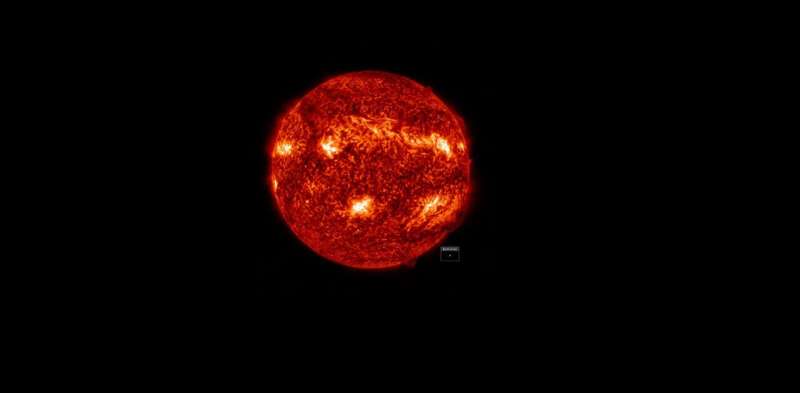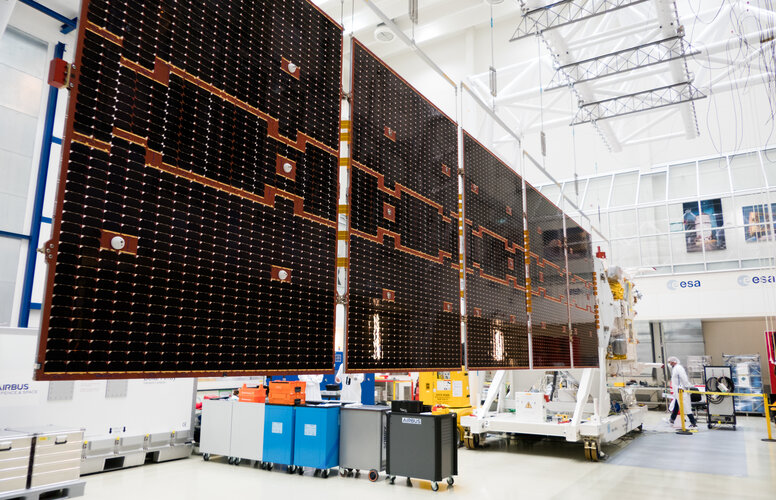
Copernical Team
Solar storm to hit Earth's magnetic field on July 21

Something is happening to the sun. One of the regions of the solar atmosphere currently exhibiting sunspots caught the attention of observatories on July 11, when there was a sudden increase in ultraviolet and X-ray brightness. The next ones to notice were the amateur radio communities on either side of the Pacific Ocean, when their communications were briefly interrupted.
A solar flare—the emission of electromagnetic radiation and energetic particles located in a small region of the solar atmosphere—had just occurred. It is a region where the magnetic field is particularly strong and complex.
SPECTACULAR FILAMENT ERUPTION: A filament stretching halfway across the solar disk became unstable and erupted away from the Sun. Couple things to note: (1) A section of it twists (magnetic energy being released).
EarthCARE takes a big stretch

ESA’s upcoming EarthCARE satellite mission has just taken a big stretch. Engineers have gently unfolded this new satellite’s huge five-panel solar wing to test that it will deploy correctly once it is in space. The solar wing is a critical part of the satellite, providing the energy for EarthCARE to do its job: to quantify the role that clouds and aerosols play in heating and cooling Earth’s atmosphere.
BlueWalker 3 test satellite fully assembled and shipped
 AST SpaceMobile, Inc. (NASDAQ: ASTS) reports that its BlueWalker 3 test satellite has been fully assembled and left its Midland, TX headquarters and manufacturing facility.
Over the next few weeks, BlueWalker 3 will be undergoing final environmental testing at an off-site facility in California, which will provide flight data to be used during the launch at Cape Canaveral. Following this a
AST SpaceMobile, Inc. (NASDAQ: ASTS) reports that its BlueWalker 3 test satellite has been fully assembled and left its Midland, TX headquarters and manufacturing facility.
Over the next few weeks, BlueWalker 3 will be undergoing final environmental testing at an off-site facility in California, which will provide flight data to be used during the launch at Cape Canaveral. Following this a Gemini's GHOST captures exquisite first light observations of chemically rich star
 Gemini South, one of the world's most productive and powerful optical-infrared telescopes, received a major capability boost with the successful installation of a new high-resolution spectrograph called GHOST constructed by an international consortium. This cutting-edge scientific instrument will expand our understanding of the earliest stars, the chemical fingerprints of distant planetary syste
Gemini South, one of the world's most productive and powerful optical-infrared telescopes, received a major capability boost with the successful installation of a new high-resolution spectrograph called GHOST constructed by an international consortium. This cutting-edge scientific instrument will expand our understanding of the earliest stars, the chemical fingerprints of distant planetary syste Hey Siri: How Much Does This Galaxy Cluster Weigh
 It's been nearly a century since astronomer Fritz Zwicky first calculated the mass of the Coma Cluster, a dense collection of almost 1,000 galaxies located in the nearby universe. But estimating the mass of something so huge and dense, not to mention 320 million light-years away, has its share of problems - then and now. Zwicky's initial measurements, and the many made since, are plagued by sour
It's been nearly a century since astronomer Fritz Zwicky first calculated the mass of the Coma Cluster, a dense collection of almost 1,000 galaxies located in the nearby universe. But estimating the mass of something so huge and dense, not to mention 320 million light-years away, has its share of problems - then and now. Zwicky's initial measurements, and the many made since, are plagued by sour Webb telescope may have already found most distant known galaxy
 Just a week after its first images were shown to the world, the James Webb Space Telescope may have found a galaxy that existed 13.5 billion years ago, a scientist who analyzed the data said Wednesday.
Known as GLASS-z13, the galaxy dates back to 300 million years after the Big Bang, about 100 million years earlier than anything previously identified, Rohan Naidu of the Harvard Center for As
Just a week after its first images were shown to the world, the James Webb Space Telescope may have found a galaxy that existed 13.5 billion years ago, a scientist who analyzed the data said Wednesday.
Known as GLASS-z13, the galaxy dates back to 300 million years after the Big Bang, about 100 million years earlier than anything previously identified, Rohan Naidu of the Harvard Center for As A New Method to Detect Exoplanets
 In recent years, a large number of exoplanets have been found around single 'normal' stars. New research shows that there may be exceptions to this trend. Researchers from the Autonomous University of Nuevo Leon (UANL), the National Autonomous University of Mexico (UNAM), and New York University Abu Dhabi suggest a new way of detecting dim bodies, including planets, orbiting exotic binary stars
In recent years, a large number of exoplanets have been found around single 'normal' stars. New research shows that there may be exceptions to this trend. Researchers from the Autonomous University of Nuevo Leon (UANL), the National Autonomous University of Mexico (UNAM), and New York University Abu Dhabi suggest a new way of detecting dim bodies, including planets, orbiting exotic binary stars When Mars throws you a curveball Sol 3539-3540
 The rover has been making its way along the "Bolivar" ridge, dodging small boulders and rocks that have apparently eroded off the hillside as seen in the above engineering camera image. Unfortunately, due to the complex terrain our last drive ended about 11 meters short of its anticipated location.
Because of the unexpected rover heading, the antenna we usually use to uplink plans directly
The rover has been making its way along the "Bolivar" ridge, dodging small boulders and rocks that have apparently eroded off the hillside as seen in the above engineering camera image. Unfortunately, due to the complex terrain our last drive ended about 11 meters short of its anticipated location.
Because of the unexpected rover heading, the antenna we usually use to uplink plans directly Unequal siblings: Ius and Tithonium Chasma
 When NASA's Mariner 9 spacecraft reached Mars more than 50 years ago at the end of 1971 and began to explore the planet from orbit, there was initially great disappointment at the control centre: virtually nothing could be seen in the images sent to Earth. At that time, a global dust storm was raging on Mars, which made it impossible to see the surface. Only the peaks of the highest volcanoes st
When NASA's Mariner 9 spacecraft reached Mars more than 50 years ago at the end of 1971 and began to explore the planet from orbit, there was initially great disappointment at the control centre: virtually nothing could be seen in the images sent to Earth. At that time, a global dust storm was raging on Mars, which made it impossible to see the surface. Only the peaks of the highest volcanoes st Futuristic Space Habitat lands at Institut Auf Dem Rosenberg
 Pioneering Swiss boarding school Institut auf dem Rosenberg unveiled today - the anniversary of Neil Armstrong and Buzz Aldrin's famous moon landing - the Rosenberg Space Habitat (RSH), which will serve as an experimental lab for students to explore and actively shape the future of humanity on our planet and beyond. Co-created by Rosenberg students and SAGA Space Architects with sustainable mate
Pioneering Swiss boarding school Institut auf dem Rosenberg unveiled today - the anniversary of Neil Armstrong and Buzz Aldrin's famous moon landing - the Rosenberg Space Habitat (RSH), which will serve as an experimental lab for students to explore and actively shape the future of humanity on our planet and beyond. Co-created by Rosenberg students and SAGA Space Architects with sustainable mate 